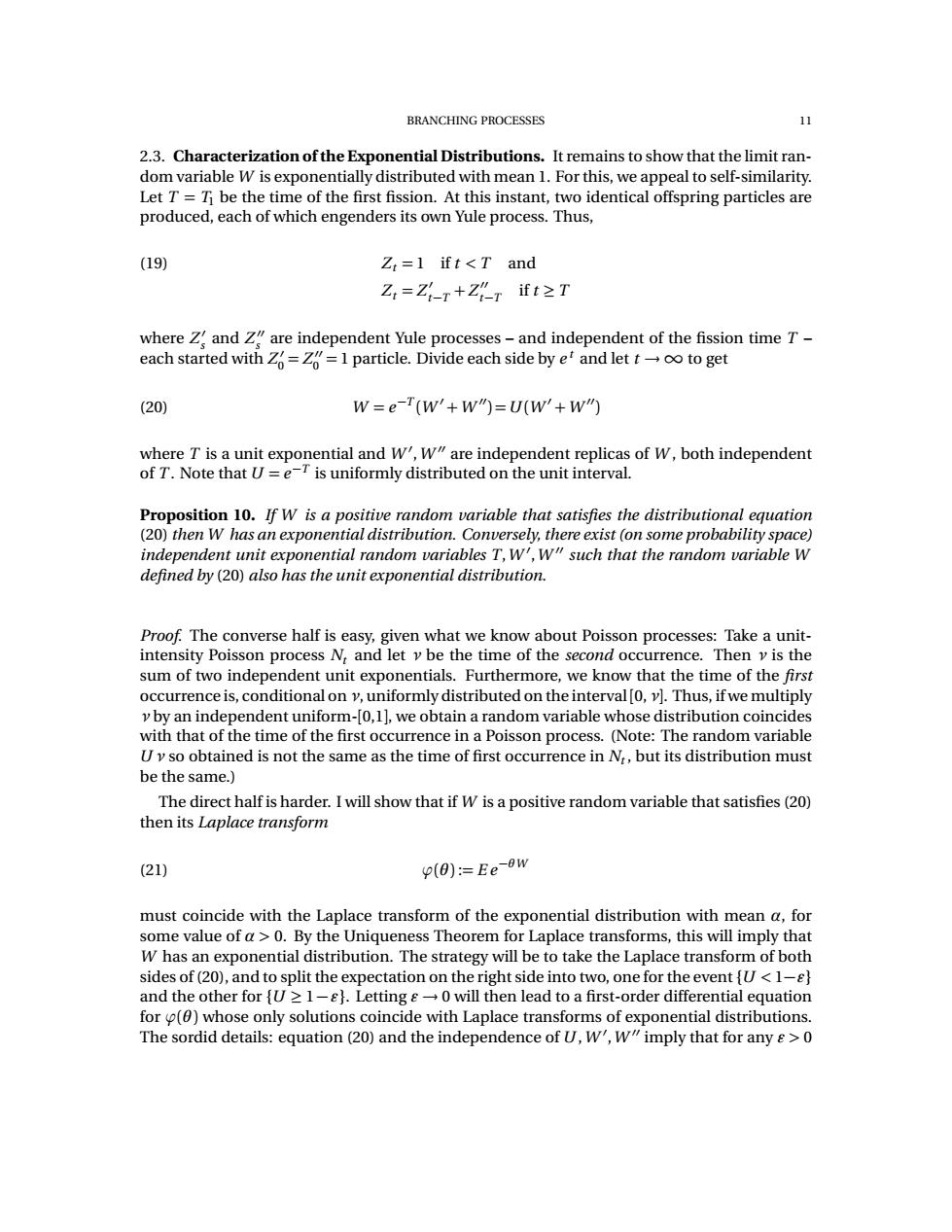正在加载图片...

BRANCHING PROCESSES 11 2.3.Characterization of the Exponential Distributions.It remains to show that the limit ran- dom variable W is exponentially distributed with mean 1.For this,we appeal to self-similarity. Let T=Ti be the time of the first fission.At this instant,two identical offspring particles are produced,each of which engenders its own Yule process.Thus, (19) Z=1 ift<T and Z,=Z-r+ZT ift≥T where Z;and Z are independent Yule processes-and independent of the fission time T- each started with=Z=1 particle.Divide each side by e and let toto get (20) W=e-T(W'+W"=U(W'+W") where T is a unit exponential and W',W"are independent replicas of W,both independent of T.Note that U=e-T is uniformly distributed on the unit interval. Proposition 10.If W is a positive random variable that satisfies the distributional equation (20)then W has an exponential distribution.Conversely,there exist(on some probability space) independent unit exponential random variables T,W',W"such that the random variable W defined by(20)also has the unit exponential distribution. Proof.The converse half is easy,given what we know about Poisson processes:Take a unit- intensity Poisson process N,and let v be the time of the second occurrence.Then v is the sum of two independent unit exponentials.Furthermore,we know that the time of the first occurrence is,conditional on y,uniformly distributed on the interval[0,v).Thus,if we multiply v by an independent uniform-[0,1],we obtain a random variable whose distribution coincides with that of the time of the first occurrence in a Poisson process.(Note:The random variable Uy so obtained is not the same as the time of first occurrence in N,but its distribution must be the same.) The direct half is harder.I will show that if W is a positive random variable that satisfies(20) then its Laplace transform (21) p(0):=Ee-8w must coincide with the Laplace transform of the exponential distribution with mean a,for some value of a >0.By the Uniqueness Theorem for Laplace transforms,this will imply that W has an exponential distribution.The strategy will be to take the Laplace transform of both sides of(20),and to split the expectation on the right side into two,one for the event {U<1-g} and the other for {U >1-g).Letting g-0 will then lead to a first-order differential equation for ()whose only solutions coincide with Laplace transforms of exponential distributions. The sordid details:equation(20)and the independence of U,W,W"imply that for any s>0BRANCHING PROCESSES 11 2.3. Characterization of the Exponential Distributions. It remains to show that the limit random variable W is exponentially distributed with mean 1. For this, we appeal to self-similarity. Let T = T1 be the time of the first fission. At this instant, two identical offspring particles are produced, each of which engenders its own Yule process. Thus, Zt = 1 if t < T and(19) Zt = Z 0 t −T + Z 00 t −T if t ≥ T where Z 0 s and Z 00 s are independent Yule processes – and independent of the fission time T – each started with Z 0 0 = Z 00 0 = 1 particle. Divide each side by e t and let t →∞ to get (20) W = e −T (W 0 +W 00) =U (W 0 +W 00) where T is a unit exponential and W 0 ,W 00 are independent replicas of W , both independent of T . Note that U = e −T is uniformly distributed on the unit interval. Proposition 10. If W is a positive random variable that satisfies the distributional equation (20) then W has an exponential distribution. Conversely, there exist (on some probability space) independent unit exponential random variables T,W 0 ,W 00 such that the random variable W defined by (20) also has the unit exponential distribution. Proof. The converse half is easy, given what we know about Poisson processes: Take a unitintensity Poisson process Nt and let ν be the time of the second occurrence. Then ν is the sum of two independent unit exponentials. Furthermore, we know that the time of the first occurrence is, conditional on ν, uniformly distributed on the interval [0,ν]. Thus, if we multiply ν by an independent uniform-[0,1], we obtain a random variable whose distribution coincides with that of the time of the first occurrence in a Poisson process. (Note: The random variable U ν so obtained is not the same as the time of first occurrence in Nt , but its distribution must be the same.) The direct half is harder. I will show that if W is a positive random variable that satisfies (20) then its Laplace transform (21) ϕ(θ ) := E e −θW must coincide with the Laplace transform of the exponential distribution with mean α, for some value of α > 0. By the Uniqueness Theorem for Laplace transforms, this will imply that W has an exponential distribution. The strategy will be to take the Laplace transform of both sides of (20), and to split the expectation on the right side into two, one for the event {U < 1−"} and the other for {U ≥ 1 − "}. Letting " → 0 will then lead to a first-order differential equation for ϕ(θ ) whose only solutions coincide with Laplace transforms of exponential distributions. The sordid details: equation (20) and the independence of U ,W 0 ,W 00 imply that for any " > 0